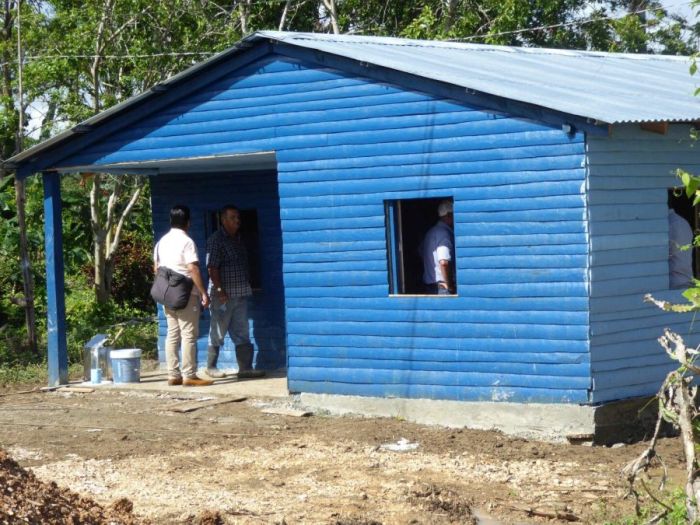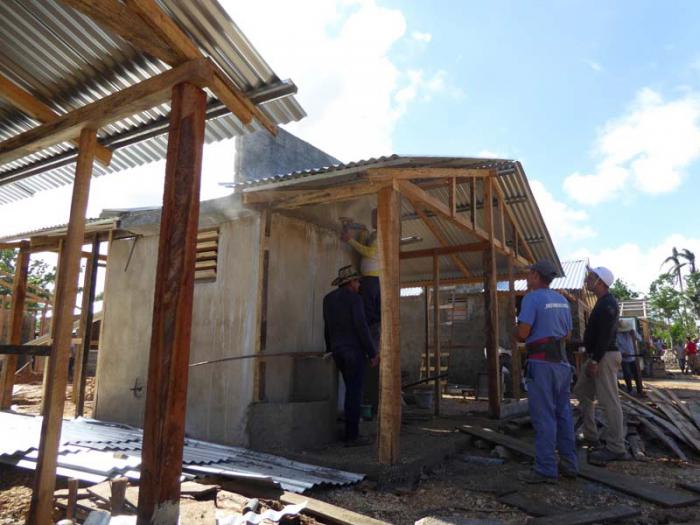
Among the plain truths said by combatant Gustavo Castellon Melian fighter, best known in Cuba as El Caballo de Mayaguara (The Mayaguara’s Horse), there is one that seems to be impossible to deny: there’s no other place in the island with so many royal palm trees as the area located between Yaguajay and Caibarien.
The assertion remains fully valid even after the devastating passage of Hurricane Irma, which turned the region into a real hell with ramshackle houses on both sides of the Circuito Norte (North Circuit) road, and the vegetation reduced to a motley mash in which palm trees did not always have the worst of luck.
Taking advantage of misfortune was the wise conclusion reached by the inhabitants of the region and the authorities of the territory, who for some time now try to transfigure the landscape with dozens of rustic houses built with palm tree wood, tiles and cement.
When Escambray visited the region last November 15th, the workers of the local Obdulio Morales Agricultural Enterprise had already prepared more than 6,000 wooden planks and were hoping to increase their deliveries from 450 to 600 per day, the equivalent of five households.

IN THE NEW SEIBABO
According to Yaguajay’s most famous palm tree topper, Genaro Concepción, known as Timbales by his closest friends, there is no tree as good as the royal palm tree on earth: “We can get timber from its trunk, the leaves are good for roofing, the fibrous tissues from the wood (yagua, in Spanish) is the best to cure tobacco and its fruit (palmiche, in Spanish) is great to fatten up pigs”.
With a similar point of view, Magda Gil awaits for her new home, “a very fairly house”, as she defines the dwellings being constructed for the urbanization process of the district of Seibabo, the first of which are almost ready to be occupied. “I choose the palm tree wood”, she says as she prepares a snack for the workers of the Obdulio Morales Agricultural Enterprise, in charge of the construction of the houses.
The idea has been finding followers everywhere in Yaguajay, especially in this community, where a new neighborhood is about to be born for the families who lost their homes due to the recent hurricane, an initiative supported by the main companies of the province.
Marelys Cedeño Cardoso, president of the Municipal Assembly of People’s Power in Yaguajay, describes the houses being built in the new community as “durable and comfortable”. On the other hand, Néstor Borroto, provincial director of the Housing Company said that out of the 250 similar houses scheduled for construction in the province, 170 will be built in this territory.

THE PALM TREE CANNOT SOLVE EVERYTHING
The technicians and specialists from the Construction and Assembly Company of Sancti Spíritus have been trying for several days to mount a new plant for the manufacture of hydraulic concrete in the area of El Yigre, next to Yaguajay.
The plant, which could produce up to 240 cubic meters of concrete in a day, is key to the recovery of a territory where 1 281 homes were totally destroyed. 698 of these houses will be rebuilt by the State while the rest will be reconstructed with the implementation of the so-called people’s own effort program.
Since not everything can be solved just with palm tree wood and tiles, arrangements are already underway to build the first petrocasas (a type of Venezuelan family houses) in a location near the road linking this territory with the nearby municipality Caibarién.

Solutions to the 25% of the so-called partial affections were posible with the construction materials being sold to the population, a good news that fortunately the people of Yaguajay has learned to look at with cautious optimism in view of the higher mountain they have yet to climb.
 Escambray ENGLISH EDITION
Escambray ENGLISH EDITION





Escambray reserves the right to publish comments.